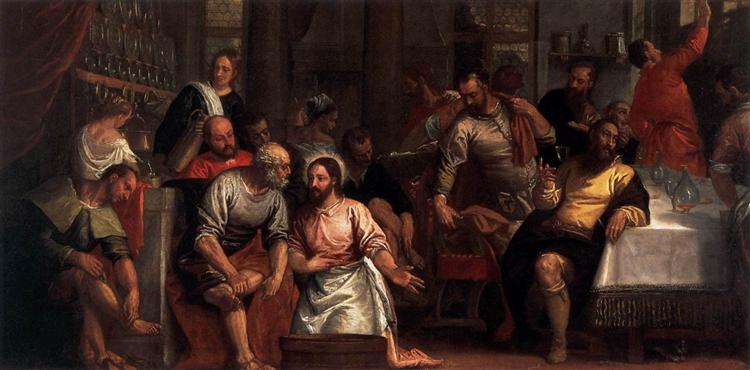Descrizione
Paolo Veronese's 1580 painting Christ Washing the Disciples' Feet is a masterful example of the Venetian style that dominated late Renaissance painting. Known for his ability to weave complex narratives through composition and his virtuoso use of color, Veronese captures a moment of profound religious significance in this painting, reflecting both the divinity of the act it depicts and the humanity of the characters involved.
In the painting, Christ is presented in the center of the composition, leaning towards one of his disciples, in a gesture that fuses grace with humility. The scene is filled with a visual rhetoric that invites the viewer to contemplate not only the act of washing feet, an act of service and self-denial, but also its spiritual meaning. This laboratory of human emotions is made evident through the expression and posture of the disciples, who, in different attitudes, understand the moving nature of the act they are witnessing. The dramatic tension is palpable, especially in the figure of Judas, who is in the central plane and seems to hesitate before Christ's gesture of humility.
Veronese's composition is notable for its formal balance. It is arranged in such a way that the viewer's gaze is gently guided towards the centre, where the symbolic act of washing is found. The use of diagonals is also crucial, as the figures are arranged in a movement that runs through the work from one side to the other, creating a dynamic that flows even in a scene as static as this one.
In the realm of color, Veronese displays his mastery of the vibrant, richly nuanced palette that is characteristic of his work. The warm tones in the clothing, which vary from gold to crimson, bring a sense of opulence that contrasts with the humility of the act depicted. At the same time, the subtle effects of light and shadow reinforce the three-dimensionality of the figures, intensifying their expressiveness.
In terms of iconography, this work fits into a rich tradition of depictions of the washing of the feet, a passage from the New Testament that symbolises Christ's servitude to humanity. However, Veronese's interpretation is particularly personal and emotive; his focus is often on human interaction, rather than pure divinity. This aspect characterises his work and distinguishes him from contemporaries such as Tintoretto or Caravaggio, who often emphasised the drama of light and shadow.
The setting that frames the scene also deserves attention. Although minimalist, the atmosphere suggests an intimate space, a place of contemplation where an everyday act full of meaning is carried out. This environment encourages a deeper, almost introspective contemplation, suggesting that the sacred can be found in the mundane.
"Christ Washing the Disciples' Feet" is not only a representation of the biblical event, but is also a reflection of the social and spiritual concerns of its time. Veronese, in his narrative skill and technical virtuosity, manages to transcend the specific moment it depicts and offer a mirror of human relationships and dignity in servitude.
In this work, Paolo Veronese demonstrates that religious painting can be a vehicle for social, emotional and spiritual analysis, turning an episode of humility into a celebration of human connection. The painting invites the viewer to consider the serenity and beauty that emerge from selfless service, as well as the complexity of the dynamic between master and apprentice, which endures to this day.
KUADROS ©, a famous painting on your wall.
Hand-made oil painting reproductions, with the quality of professional artists and the distinctive seal of KUADROS ©.
Painting reproduction service with satisfaction guarantee. If you are not completely satisfied with the replica of your painting, we will refund 100% of your money.

